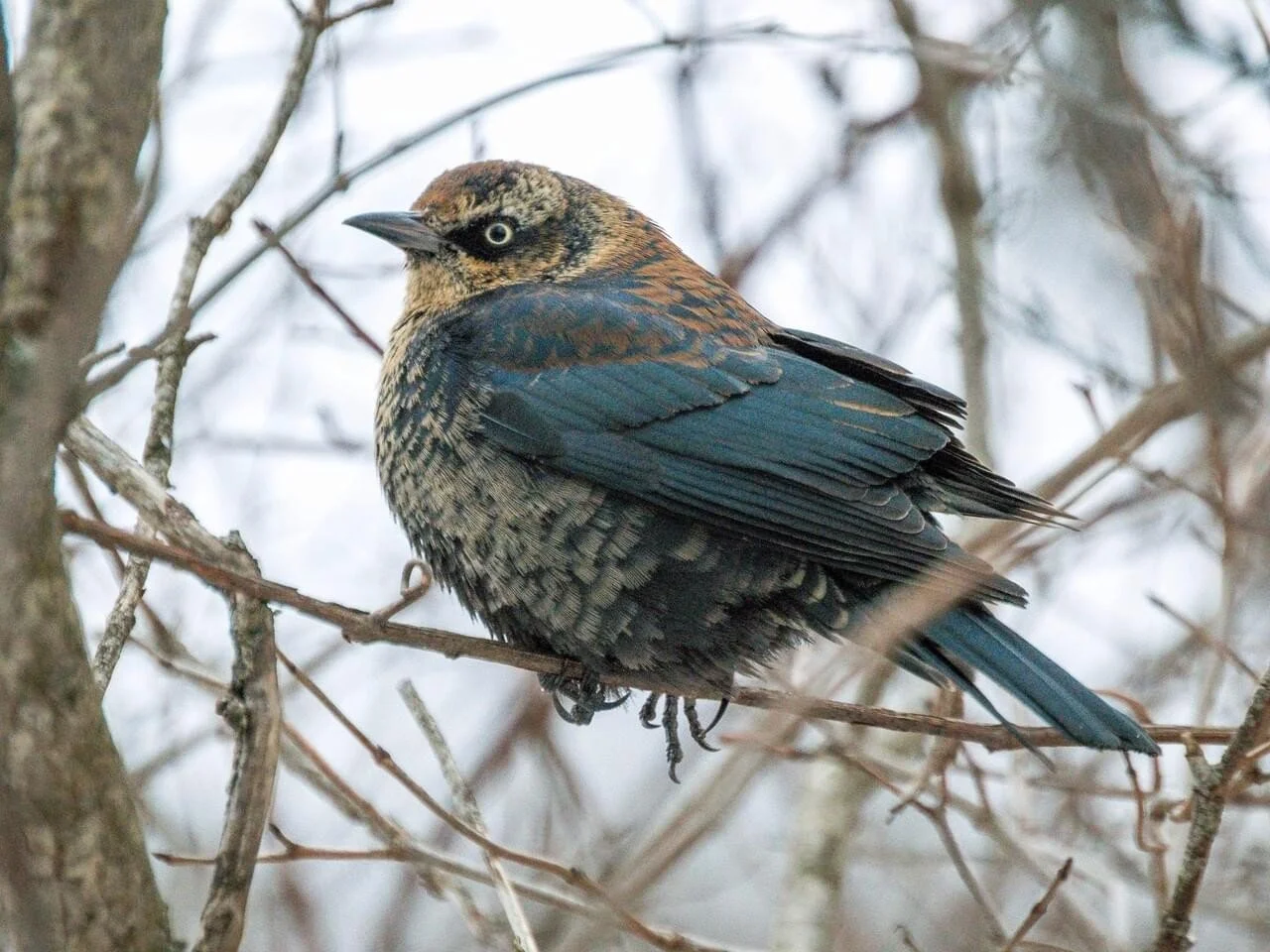It’s the fall bird migration now, but that doesn’t make the spring migration count any less interesting! Sixty-seven species were spotted this year in the Green Acres area, nine more than last year (but fewer than in 2023 when 76 were counted.) What is exciting is that a Rusty Blackbird was spotted, the first time for this species which is in steep decline.
Billions of birds migrate north in April and May, a favorite time for birders to do a count. John Boright, Mike Flibbert, and Jane Padelford Gomes have been sharing their spring count since 2021. This year’s count for Green Acres included eight types of warblers as well as crows, robins, orioles, owls, indigo buntings, scarlet tanagers, hummingbirds, herons, kinglets (two types), three types of woodpeckers, two types of flycatchers, and wood ducks as well as the Rusty Blackbird who was probably on its way to the boreal forests of Canada where it breeds. (Scroll down to see the whole list.) The Rusty Blackbird loves wetland areas, much like the area with rough horsetail (Equisetum hyemale) that lives along the trail from Yorktown Road heading towards Little Falls Parkway. Fun fact: Equisetum is the single surviving genus of a class of primitive vascular plants that dates back to the mid-Devonian period (350 + million years ago).
Rough Horsetail freed from non-native invasives at the Green Acres Habitat Project.
green acres project is all native plants
The Green Acres Habitat Restoration has transformed the area between Yorktown and Wakefield Roads on the banks of the Little Falls Branch into a native plant haven. It’s the brain child of Jane who approached us in 2016 to ask for our support in restoring this area. What once was non-native invasives, and a muddy path across a grassy area is now a pollinator garden, a woodlands area, new native trees. Native plants attract lots of birds, so we were not surprised when we learned that the bird count has increased by as much as 40% some years. The area is alive with butterflies and bees and other insects. Caterpillars feed on the plant leaves and in the trees. And the seed heads from the native flowers provide year round food. Learn more about the Green Acres Project HERE.
Rusty Blackbird
The Rusty Blackbird ( (Euphagus carolinus) is one of North America’s most rapidly declining species. It gets its name from its song which sounds like a squeaky door hinge, and its rusty-colored feathers. The population has plunged an estimated 85 to 99 percent since 1985. They live in wooded swamps mostly in the southeastern U.S., breed in the boreal forests of Canada, and winter in the Eastern U.S. where they travel in small flocks. Their steep decline is attributed to high mercury contamination from burning coal that falls as toxic rain in the boreal forests and loss of wetland habitat in the southeastern U.S. The Rusty Blackbird forages on the ground for insects, acorns, pine seeds and fruit, and can live to be eight years old.
2025 Spring Migration Bird Count
Birds seen near the Green Acres Habitat and Westbrook Elementary School
Viewed by John Boright, Mike Flibbert and Jane Padelford
March 13 to May 31, 2025
For birds marked with (2025) it is the first time they have been spotted here since we began surveying in 2021.
American Crow
American Goldfinch
American Redstart
American Robin
Baltimore Oriole
Barred Owl
Blue Jay
Blue-Grey Gnatcatcher
Brown-headed Cowbird
Carolina Chickadee
Carolina Wren
Cedar Waxwing
Chimney Swift
Common Grackle
Common Yellowthroat
Coopers Hawk
Dark-eyed Junco
Downie Woodpecker
Eastern Towhee
European Starling
Gray Catbird
Great Blue Heron
Fish Crow
Golden Crowned Kinglet
Great-Crested Flycatcher
House Finch
House Sparrow
Indigo Bunting
Mallard Duck
Mourning Dove
Northern Cardinal
Northern Flicker
Northern Mockingbird
Northern House Wren
Northern Parula
Northern Waterthrush
Pileated Woodpecker
Red-bellied Woodpecker
Red-eyed vireo
Red-tailed Hawk
Red-shouldered Hawk
Red-winged Blackbird (2025)
Ruby-Crowned Kinglet
Ruby‐throated hummingbird
Rusty Blackbird (*a first for this area seen by J. Boright)
Scarlet Tanager
Sharp-shinned Hawk (2025)
Solitary Sandpiper
Song Sparrow
Swainson’s Thrush
Swamp Sparrow (2025)
Tufted Titmouse
Warblers ‐ Blackpoll Warbler
Warblers – Canada Warbler
Warblers ‐ Cape May Warbler
Warblers – Chestnut-sided Warbler
Warblers ‐ Magnolia Warbler
Warblers - Wilsons Warbler
Warblers ‐ Yellow-Rumped Warbler
Warblers ‐ Yellow Warbler
White-eyed Vireo (2025)
White-Throated Sparrow
White-breasted Nuthatch
Winter Wren (2025)
Wood Duck
Wood thrush
Yellow-crowned night heron (2025)
Key
* a first for this area
(2025) - first sighting since this survey was begun in 2021


